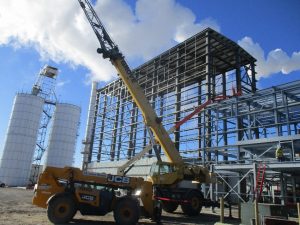Iowa Ethanol Plant Expansion
The Iowa Ethanol Producer needed to repurpose existing buildings and structures, as well as add two new buildings, to be able to install a new DDG decanting, drying, and loading system.
This project started in the conceptual phase and went through all phases including start-up and commissioning. Engineering and design was done on a fast-track schedule and took five months to complete.
Work Completed:
- Started structural design while equipment and vendor selections were still being finalized. A strategic design approach was taken in order to continuously adapt to evolving information while also limiting rework.
- Incorporated existing 4-foot thick reinforced concrete mats into the foundation design of the new structures to reduce demolition and construction costs.
- Repurposed an existing truck unload structure by designing an economical method of filling a 16-foot-deep pit with lean concrete.
- Designed an approximately 4,500 square feet two-story building extension to house new decanter equipment. This structure included:
- An elevated second floor concrete slab and drain system for containment.
- Design considerations for future decanter additions.
- Removable wall panels and a 5-ton monorail system for servicing or adding equipment.
- Designed another approximately 2,900 square feet building extension to house new drying equipment.
- Repurposed an existing 4,600 square foot building by adding a new set of stairs to increase egress and by framing a new level for supporting a 20 psf utility load.
- Designed a 30-foot extension of an existing MCC structure.
- Repurposed steel and existing foundations from an existing 140-foot long conveyor bridge to carry the new conveyor at a new elevation to facilitate the new process.
- Designed several new access platforms for new equipment drives and motors.
- Designed several new pipe supports for new process lines.
- Ran Finite Element Analysis (FEA) of all the new and existing structures to evaluate their capacities against the new equipment weights and all applicable loading per the latest building code.
- Issued 34 structural CAD drawings.


